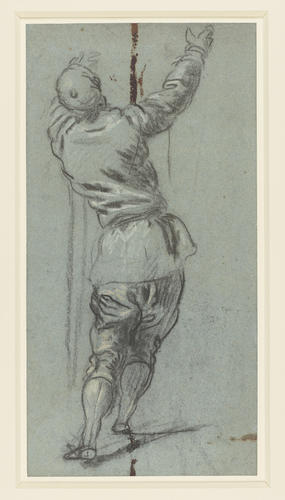A man from behind c. 1555
Black and white chalks, with white heightening and brown oil paint, on blue paper | 36.8 x 18.8 cm (sheet of paper) | RCIN 904823
-
A drawing of a man seen from the back, with his left arm outstretched above his head.
The drawing is a study for a man at the foot of a ladder in Tintoretto's Crucifixion, painted for the church of San Severo, Venice and now in the Accademia. It is a finely preserved example of the artist's rapid drawing technique, with the line of the cross in the final composition added with a couple of strokes of brown oil paint. Such drawings must have been executed in huge numbers by Tintoretto, but only a tiny proportion survive. This drawing is a study for the turbaned man at the foot of a ladder, in the centre of Tintoretto's canvas of the Crucifixion, painted for the church of San Severo, Venice, removed in 1791 and now in the Accademia. Surprisingly, the canvas is not documented and has been remarkably widely dated, between the 1540s and 1560s, but most recent scholars have recognised in the painting Tintoretto's closest engagement with the works of Paolo Veronese, shortly after that artist arrived in Venice in 1553.
The drawing is a finely preserved example of Tintoretto's characteristic drawing style, working with his usual media of black chalk on blue paper, here heightened with both white chalk and white lead, and with the line of the cross in the final composition added, probably later, with a couple of strokes of brown oil paint. Such drawings must have been executed in huge numbers by the artist, but they were the epitome of the preparatory sketch, dashed off to capture a pose and of little use to the artist once their immediate purpose had passed, and only a small proportion survive. W.R. Rearick emphasised the conservatism of Tintoretto's drawing habits, pointing out that although he sometimes added pen, wash and white to his chalk drawings, and occasionally worked with brush and ink, he apparently never worked in pen and ink or pen and wash alone, and never in red chalk. Two other drawings for the Crucifixion are known: a squared study of the soldiers dicing for Christ's clothes (actually two separate drawings on two joined pieces of paper) in the Uffizi; and, less certainly connected with the painting, a sketch for the woman supporting the swooning Virgin in the Courtauld Institute.
Catalogue entry adapted from The Art of Italy in the Royal Collection: Renaissance and Baroque, London, 2007Provenance
Royal Collection before c.1802 (Inventory A, p. 85, Scuola Veneziano, among '38 to 43. Tintoretto').
-
Creator(s)
-
Medium and techniques
Black and white chalks, with white heightening and brown oil paint, on blue paper
Measurements
36.8 x 18.8 cm (sheet of paper)









